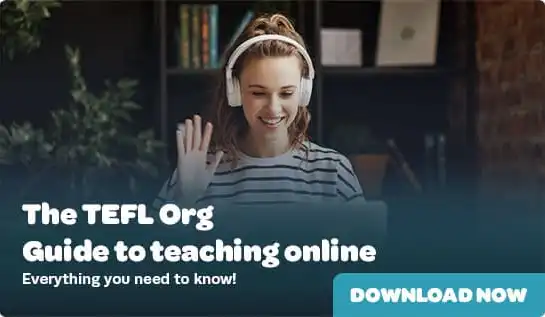- TEFL Courses
- New to TEFL New to TEFL
- Locations
- TEFL Jobs
- Teach Abroad Teach Abroad
- Teach English Abroad
- Teach English in Japan
- Teach English in South Korea
- Teach English in Spain
- Teach English in China
- TEFL Salaries Abroad
- Requirements for teaching abroad
- Teach English abroad without a degree
- How to find teaching jobs abroad without experience
- Can you teach English abroad as a non-native speaker?

- Teach Online
- About Us
- Blog
- Podcast
Teaching Online with Open English
If you’re a North American citizen, a native English speaker and can dedicate 10 hours a week to online teaching, Open English is a great option!


TEFL course provider
TEFL certificate
teachers trained
find work within 2 months
There are plenty of online English teaching platforms that cater to specific markets around the world. Take LatinHire or Ginseng English, for example, which are geared towards learners from Latin America and South Korea respectively. Open English is an English teaching platform that is aimed towards the Spanish-speaking market, which is nothing new. The difference, though? Unlike other platforms and companies, you’re teaching to a whole class.
Yes, while one-to-one direct tutoring is the dominant formula in online English teaching, Open English is, like its name suggests, open to all sorts of different students, with a more loose, conversational feel than many of its counterparts. Classes are constantly available; if you’re a qualified TEFL teacher, all you have to do is log in and get started!
So, what does any curious TEFL teacher need to make a living teaching on Open English? What are the requirements, what’s the typical salary like, and how does it compare to other online English teaching platforms?
Let’s explore!
Open English: Overview
Founded in 2006, Open English began in Caracas, Venezuela, as a resource for Latin and South American English learners. Typically, lessons would be held by native English speakers from North America, with co-founder Nicolette Rankin playing such a role in their advertising.
Over subsequent years, venture capital helped Open English to grow exponentially, with students joining the service from all over the world. According to their website, they’ve had over 1.5 million learners, employing over 2,000 teachers, and becoming “#1 online English learning method in Latin America and the US Hispanic market”.
You’ll notice the major discrepancy between the number of teachers and the number of students. This is because, unlike most other online English teaching platforms, Open English is for classes as opposed to one-on-one lessons. These classes include adults, children and corporate clients.
As well as Open English, the company offers Next U for higher education, Open English Business, Open English Junior (for 8-14 year-olds) and Open English Mundo, the latter of which provides classes in a range of other languages.Requirements to Teach with Open English
So what does an English teacher need on their CV to start teaching with Open English? The first thing to point out is that you need to be a native English speaker from North America; if you’re based elsewhere, there are loads of other great options for teaching English online!
If you are, indeed, from North America and you’re wondering what other requirements you need to teach with Open English, read on!
Degree/No Degree
While obviously, a four-year bachelor’s in any subject is a welcome boost to any application, it’s not a prerequisite for teaching with Open English. Generally speaking, if you do have a degree, especially in a relevant subject, it’ll definitely help your application. However, not having one won’t be a total deal-breaker if you can demonstrate ability in other ways.
TEFL Certification
A TEFL certificate is hugely preferred in order to teach through Open English. The industry standard for TEFL certification is 120 hours of teaching. Open English have specific offerings for young learners and those interested in Business English - Open English Junior and Open English Business, respectively - therefore an advanced TEFL certificate in either teaching young learners or business English would only strengthen your application.Your TEFL certificate must be from a reputable, accredited provider, and must meet the industry standard for training. A Groupon or other discount TEFL qualification won’t be enough to teach on Open English, or any worthwhile teaching platform.
Experience
While experience - like a degree - is not essential, it’s absolutely preferred. Any prior teaching experience counts when applying for Open English, especially if it’s online. Though Open English will take on new teachers, it absolutely helps if you can demonstrate expertise with online teaching software, and/or the ability to handle classes of students.
Again, it’s not a deal-breaker, but it’s extremely beneficial to have some prior teaching experience on your CV.Native/non-native
To be considered for a role with Open English, you’ll need to be a native English speaking North American citizen, with clear pronunciation and diction. Unfortunately, this massively limits the number of applicants who could feasibly work on Open English.
However, don’t be discouraged if you’ve read this far and you’re not a native English speaker. There are plenty of companies and platforms hiring non-native English speakers. Perhaps Open English will change this policy in the years ahead.
Other requirements
So what other requirements do you need to meet in order to teach with Open English?
For one thing, your time is required. Specifically, you have to commit to at least 10 hours of online teaching per week. With the considerable demand on the platform, you won’t struggle to find classes to teach, and you’ll be able to build up experience quickly.
Also, some Spanish or Portuguese isn’t a requirement, but it is significantly helpful. Certainly, at least basic proficiency will boost any job application for Open English; your students will be from Latin America, after all.Download our teaching English online guide
Job Overview
Now we know some background, and the requirements needed to teach on Open English. What’s it actually like, though? What kind of salary can you earn, what are the students like, and when is Open English at its busiest?
Let’s explore.
Open English Salary
Though Open English don’t tend to advertise their salaries too widely, research indicates that the typical hourly rate for an English teacher is between $13 and $15. With 10 hours being the minimum number of teaching hours, you can expect, then, to earn $130-$150 per week, net. You’ll be paid twice a month.
You will be treated as a freelance worker, which means you’ll need to sort your own annual tax reports.

Teaching hours
With a minimum of 10 hours of teaching and 26 hours at a maximum, you’re likely to meet a range of different students. Your availability must be stated at the start of your teaching time, and classes aren’t guaranteed.
Class size
Typically, class sizes are small (maximum 20 students), with a more intimate, direct teaching experience. It’s hardly one-to-one tutoring, and students may well have different levels of proficiency, but there’s a focus on conversational English and making quick progression.
Student ages
Typically, students will be over 14-years-old up to retirement age. Children are catered for with Open English Junior, which is a seperate service under the Open English umbrella. Depending on the types of students you teach, you may have a class that is trying to keep up with schoolwork, or adults who are preparing for a holiday. Though there is a curriculum, it’ll be up to you to keep lessons age-appropriate, especially if you’re planning on using media - such as video - in the classroom.
Open English peak hours
When are you likeliest to have classes? Well, it’s good news if you’re not a morning person; Open English is busiest during the evenings, in Eastern Standard Time. This tends to be when most students are available; after work, school, college or whatever their day consists of.
With evenings being the busiest time, it’s up to you to bring your teaching skills and conversation prompts to the fore. Students might be more prone to tiredness - keep the conversations and feedback flowing!

What is the application process for Open English?
The online application process for Open English is remarkably easy. It starts with filling out an online form, which will tell you about the history and ethos of the company, before asking questions about your qualifications and level of experience.
You’ll need a microphone, to record a short voice sample, as well as digital copies of your TEFL certificate, degree (if applicable) and resume. Your computer will also be subject to an internet speed test, there’ll be a short grammar quiz, and you’ll have the option to state your availability over a week.
If your online application is successful, you’ll be taken on to the next stage, which is…
What to consider before you start
There are plenty of things you’ll need to consider before you get started teaching on Open English:
- Time: How many hours of teaching can you commit to? Would Open English be your primary source of income, or do you want to fit teaching into your existing work schedule?
- Tech: You’ll need a headset, a working microphone, either a webcam or a computer which has a camera as standard, and an up-to-date, recently released computer (with software updates). Also, your internet connection has to be excellent.
- Financial management: As previously stated, it’s imperative to remember that your tax responsibilities are your own; Open English will take you on as a freelancer.
- Ideas: Open English has a curriculum to work to, but that doesn’t mean you abdicate creative responsibilities.
- A Wise account: This is how you’ll be paid. Register for a Wise account before you start.
Interview process
If you’ve got to this stage: congratulations! There’ll be a short interview with a member of the Open English team, or a video recording in which you set our your stall as a teacher; your experience, your qualifications, what you specialise in, and your availability should all feature here.
Provided that’s all to the platform’s liking, you’ll be brought in for onboard training. This involves getting familiar with the Open English teaching platform, and learning more about the company and its students.
Open English pros and cons
So, what do we make of Open English? If you’re a North American English teacher with plenty of time on your hands, and the ability to teach classes online, it might sound like a great option.
However, there are limitations, like any online teaching company. So let’s get into the pros and cons of teaching through Open English.
Pros
There are plenty of factors in Open English’s favour:
- Flexibility: Like all online English teaching platforms, Open English offers real flexibility. If you have outside commitments, such as care needs, another job, university or something else, the minimum of 10 hours’ teaching time isn’t a huge limitation.
- Regular payment: Teachers on Open English are paid twice a month, through a trustworthy arbiter. No need to chase up payments!
- Experience: Working with different levels of proficiency, different age groups and nationalities is excellent teaching experience that you can use in the future.
- Easy application: If you meet the requirements, this is a service that won’t waste time bringing you into the fold.
- Work with classes: The key difference between Open English and other platforms? You only work with classes, of various sizes. This is a great way to build up your teaching skills quickly, and adapt to different learning needs.
- Digital nomad: Open English has no problem letting its teachers work as digital nomads. After all, you are freelance!
- Materials and curriculum: No need to worry about teaching materials, since they’re provided for you.
Cons
However, there are difficulties with Open English that some teachers might not like:
- Salary: Compared to other platforms and companies, the salaries offered by Open English are quite low.
- Freelance contract: Since you’ll be working freelance, you won’t be subject to any employee benefits offered by other companies, and you’ll have to sort your own tax affairs.
- Minimum hours: Though there is flexibility in general, meeting your mandated 10 hours per week is important.
- Class times: Typically, according to former service users, classes were around 25 minutes. That’s not a lot of teaching time, certainly when you have a mandated 10 hour minimum.
Reviews
Online, the reviews for Open Teacher are mixed. Glassdoor users rate Open English 3.8 out of 5, with some former and current employees praising the flexibility, but unhappy about the pay, the minimum number of hours, and the leadership.
On Indeed, Open English are rated 3.7 out of 5 by current and former teachers. Some users suggest that the scheduling is excellent, and that the support offered to teachers is excellent. However, the materials aren’t to everyone’s liking, with some teachers suggesting they don’t suit every student, and are sometimes out of date.
The biggest gripe with Open English seems to be the salary, according to both aggregator sites like Glassdoor and Indeed, and independent review sites.
Frequently Asked Questions
Q. What is the Open English style?
Classes on Open English are with groups, rather than one-to-one. You can teach a range of students, of different ages, abilities and learning goals.
Q. What are the steps for applying for Open English?
To apply for Open English, you need to first fill out an online application form (including scans of relevant qualifications and your resume), then do a short video interview.
Q. How much does Open English pay?
Typically, Open English pays between $13 and $15 per hour, before tax.
Q. Do you need a degree for Open English?
No, you don’t need a degree for Open English, but you will need a high-quality TEFL certificate.












